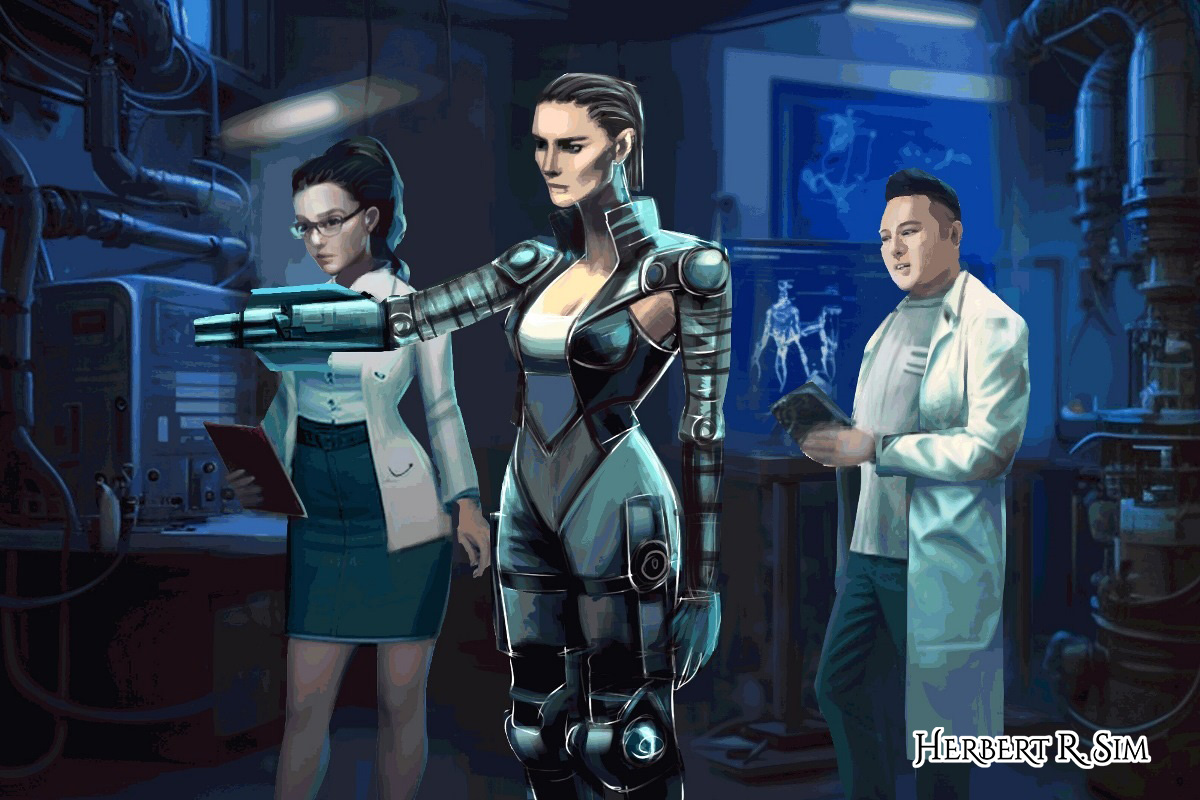
Above is my illustration work-in-progress of a female cyborg “bionic woman” testing out her neuroprosthetic limbs.
———————————————–
Imagine a world where people with physical disabilities, including amputees and those with paralysis, can regain their mobility and independence thanks to cutting-edge technology.
This is where the realm of neuroprosthetics come into play, where advanced assistive devices like artificial limbs and robotic exoskeletons – such as the wearable exomuscle, MyoShirt – can be leveraged to transform lives. From the early days of simple wooden limbs, we now have sophisticated devices that can integrate with the user’s nervous system – enabling someone with a prosthetic limb for example, to walk effortlessly almost as if it was his natural limb.
The secret sauce lies in the neural interfaces that bridge the gap between the human body and the prosthetic device. These interfaces enable the brain to communicate with and control the prosthetic limb, making it feel like a natural extension of the body.
Not a new kid on the block
The idea of controlling artificial limbs with one’s mind dates back to the 1960s when researchers started exploring brain-computer interfaces (BCIs). Early experiments involved implanting electrodes in animal brains to decode neural signals and control simple devices. Over time, advancement in materials, electronics, and software allowed for the development of more sophisticated neuroprosthetics.
Neural interfaces, in particular, became a key focus as it enables direct communication between the brain and prosthetic devices, providing an unparalleled level of control for more natural and intuitive movement. Key players in this field today include companies like Neuralink and Kernel, as well as various research teams and scientists across the world – including Dr Naweed Syed, who created the world’s first neurochip in 2005 that allowed two-way communications between a brain cell and electronics.
The neurochip is an implantable device designed to record and stimulate neural activity directly within the brain. Its ability to adapt and learn from the user’s neural activity makes it a promising tool for improving neuroprosthetic control. Researchers believe that the neurochip may eventually become the primary means of controlling neuroprosthetic devices, providing a more seamless integration between user and device. In fact, the concept of the neurochip has long been a key source of intrigue and ambition for many, reflected by Neurochip.com, a company that was set up in 1999 to study non-invasive BCI.
Neuralink, founded by Elon Musk, is also developing a BCI that uses flexible threads embedded with electrodes. These threads are implanted into the brain, transmitting neural signals to a computer that controls various devices, including neuroprosthetic limbs. On the other hand, Kernel, founded by American venture capitalist Bryan Johnson, focuses on non-invasive neural interfaces. The latter’s Flow device spots a helmet-like design, tapping infrared light to measure blood flow and oxygenation within the brain, which enables the determination of neural activity that can potentially control neuroprosthetic devices.
———————————————–

The illustration’s focus is that neuroprosthetics, or the robotic limbs controlled by the neurochip, are constantly upgradeable, and interchangeable. As per in the art, the female cyborg’s arm is upgraded to a weapon.
———————————————–
Plans and developments thus far
Researchers worldwide are working to develop innovative neuroprosthetic technologies. Some of the key focus areas include:
- More precise and efficient neural interfaces, such as the high-density electrode array being developed at the University of Pittsburgh. This technology aims to enhance control amputees have over their prosthetic limbs by recording and stimulating neural activity with greater accuracy. The increased precision of these electrode arrays could potentially enable the neurochip to be integrated more effectively, allowing for smoother communication between the user’s brain and the neuroprosthetic device.
- Soft, flexible, and lightweight materials for neuroprosthetic devices, like MIT’s stretchable material that can detect and transmit electrical signals. These advances in material science could facilitate the integration of the neurochip with neuroprosthetic devices, making them more comfortable and adaptable for users.
- Improved software and algorithms, with machine learning and artificial intelligence to deliver a more sophisticated interpretation of neural signals. The development of more accurate algorithms could allow the neurochip to provide increasingly precise control over neuroprosthetic devices, resulting in a more intuitive and seamless user experience. Advanced algorithms can also help the neurochip learn and adapt more efficiently to the user’s neural activity.
By addressing the above focus areas, researchers are working towards creating more advanced and effective neuroprosthetic devices. The successful integration of the neurochip into these devices will also offer unprecedented levels of control and functionality for users.
Neurochip: Your ideal command centre
Due to the neurochip’s unique learning and adaptability, it is an ideal central control system for neuroprosthetics. Essentially, the gadget may “train” itself to better understand the user’s goals as it learns from the individual’s cerebral activity, resulting in increasingly accurate control over time. The neurochip becomes a potent instrument for seamless integration between the user and the neuroprosthetic device as a result of this learning process.
One of the key aspects of the neurochip’s success lies in its closed-loop design. This design allows for real-time feedback between the neuroprosthetic device and the user’s brain, enabling continuous learning and adaptation. This continuous feedback loop allows the neurochip to make adjustments and fine-tune its performance, leading to more accurate and natural control of the prosthetic device.
In fact, several case studies have demonstrated the transformative potential of the neurochip in the realm of neuroprosthetics. Researchers at the University of Washington successfully tested the neurochip in a primate model, showing that the device could learn and adapt to the subject’s brain signals to control a prosthetic limb. In the study, the primate was able to control a neuroprosthetic limb with remarkable precision, highlighting the potential of the neurochip for human applications.
Another study, conducted at the University of Pittsburgh, demonstrated how the neurochip can be used to improve the control of a robotic arm for individuals with paralysis. The study showed that, after implanting the neurochip in the motor cortex of individuals with spinal cord injuries, they were able to control a robotic arm to perform various tasks, such as reaching and grasping. The neurochip’s ability to learn from the user’s brain activity resulted in more intuitive control over the robotic arm.
The studies above reflect just how crucial the neurochip can be in terms of controlling neuroprosthetic devices, apart from providing valuable insights into how it can be refined. Crucially, it has showcased its potential and paved the way for new purposes – including the restoration of lost senses and the treatment of neurological disorders, further highlighting its transformative potential in the medical field.
———————————————–

The society today has shown that people will “identify” with a gender, and willingly go under the knife for “upgrades”, similarly for plastic surgery to get certain beauty standards; thus it is a matter of time before neuroprosthetics become a trend as well.
———————————————–
Navigating challenging waters
Despite the promise of the neurochip as a central control system for neuroprosthetics, several challenges remain. These include the issue of biocompatibility as well as long-term stability of neural interfaces, so as to ensure that devices like the neurochip can be safely implanted and maintained within the brain for extended periods.
Additionally, there’s also the need to address privacy and autonomy concerns, the issue of accessibility and affordability, as well as considering the potential misuse of neural interface technologies. As researchers and companies continue to tackle these challenges, interdisciplinary collaboration between engineers, neuroscientists, and clinicians will be crucial to develop more sophisticated neuroprosthetic devices.
Neuroprosthetics, when powered by advanced neural interfaces, will harbour the potential to transform the lives of amputees and individuals with paralysis. By enabling direct communication between the brain and prosthetic devices, these technologies restore mobility, independence, and a sense of normalcy.
As research and development continue to advance, we may see further improvements in terms of functionality, intuitiveness, and as highlighted above – accessibility of neuroprosthetic technology. Such a combination will eventually go towards negating the limitations caused by physical disabilities. Amputees and people suffering from paralysis, for example, will enjoy better lives as researchers develop increasingly more effective neural interfaces and prosthetic equipment – unlocking new frontiers and more importantly, creating and instilling hope.
